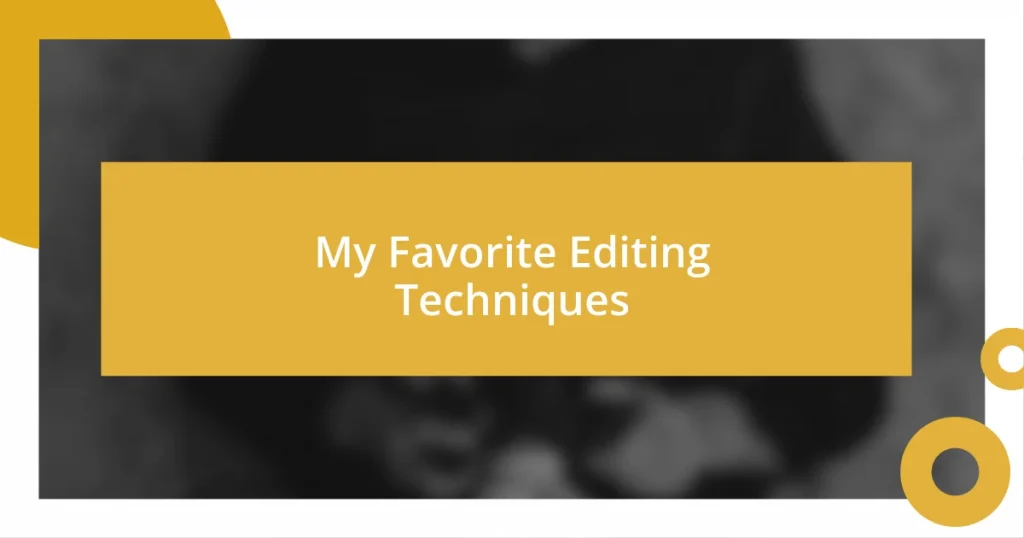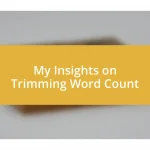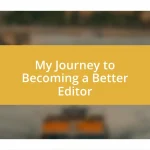Key takeaways:
- Utilizing effective editing techniques like “show, don’t tell,” seeking feedback, and maintaining a consistent editing style can significantly enhance the quality of writing.
- Selecting the right editing tools tailored to one’s workflow and combining multiple tools can improve clarity and effectiveness in the editing process.
- Finalizing edits involves focusing on emotional impact, pacing, and precise word choice to create a resonant and engaging narrative for readers.
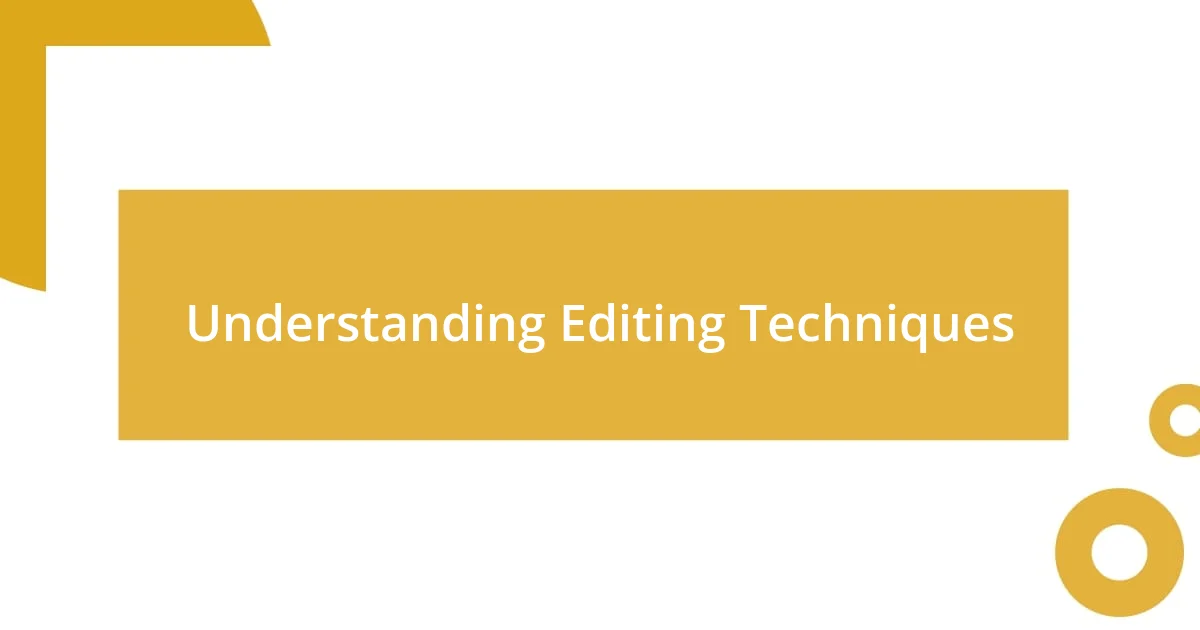
Understanding Editing Techniques
Editing techniques are the essential tools that transform a rough draft into a polished piece. I remember grappling with my first manuscript; I thought simply correcting typos was enough, but soon realized that techniques like cutting unnecessary words and restructuring sentences could elevate my writing significantly. Have you ever felt a draft just wasn’t singing? That’s likely where editing comes in.
One technique I find invaluable is the “show, don’t tell” approach. It took me a while to grasp the difference between simply stating facts and painting a vivid picture for my readers. For instance, instead of saying “she was sad,” I learned to describe her quivering lips and heavy eyelids – subtle details that resonate deeply with emotions. Have you noticed how readers connect better when they can visualize a scene?
Another technique is the use of feedback loops, where I share my work with trusted peers. The moment I started seeking constructive criticism, I realized how blind I could be to my own writing flaws. A fresh pair of eyes often brings insights that I would never have noticed on my own. How often do you seek others’ perspectives on your work? Trust me, it can transform your writing journey!
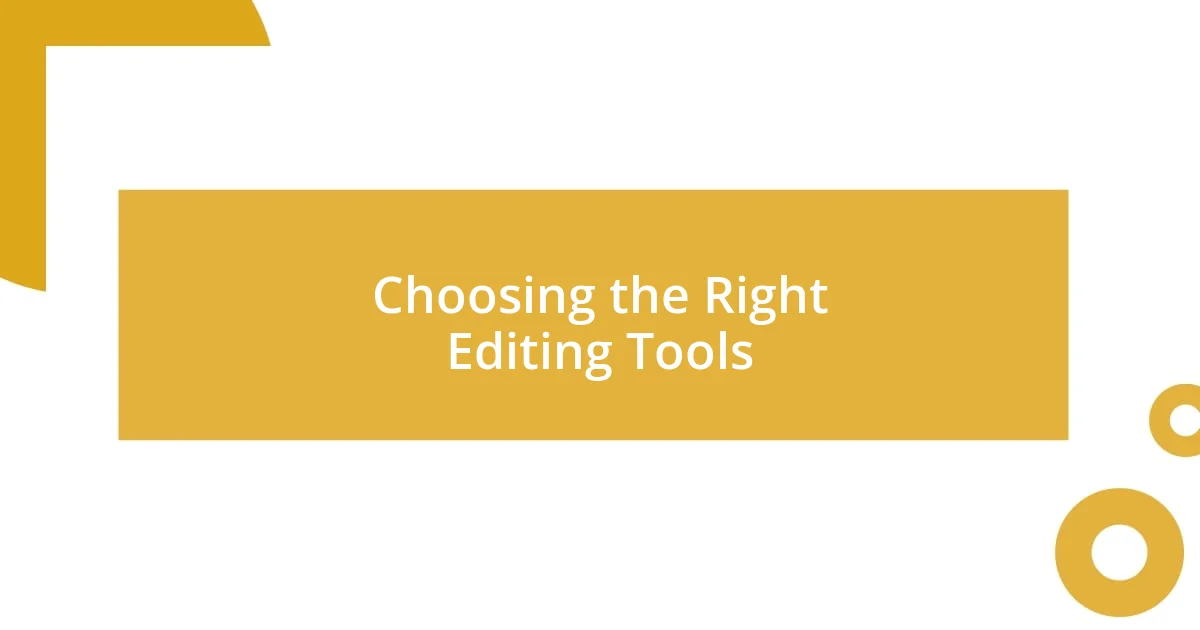
Choosing the Right Editing Tools
When it comes to selecting the right editing tools, the choices can be overwhelming. In my experience, I’ve learned that picking a tool is not just about its features but also how it resonates with my workflow. For example, I gravitate towards user-friendly interfaces because they allow me to focus more on the content rather than wrestling with the tool itself. Does that resonate with you?
Moreover, I’ve found that combining several tools often yields the best results. A grammar checker might catch the obvious mistakes, but a tool designed for style and tone can enhance my voice. I once used a popular editing app alongside a peer-review feature, which drastically improved the clarity of my writing. Have you ever tried blending tools? The synergy can lead to unexpected improvements.
In the quest for the ideal editing setup, don’t underestimate the impact of your environment. Some tools provide distraction-free modes, which can be a lifesaver when I’m deep in the editing zone. The right editing tool can turn that chaotic draft into a coherent masterpiece, so take your time to explore options until you find what clicks with your creative process.
| Tool Name | Primary Function |
|---|---|
| Grammarly | Grammar and spell check |
| Hemingway Editor | Style and readability improvement |
| ProWritingAid | Comprehensive writing analysis |
| Scrivener | Project management for writers |
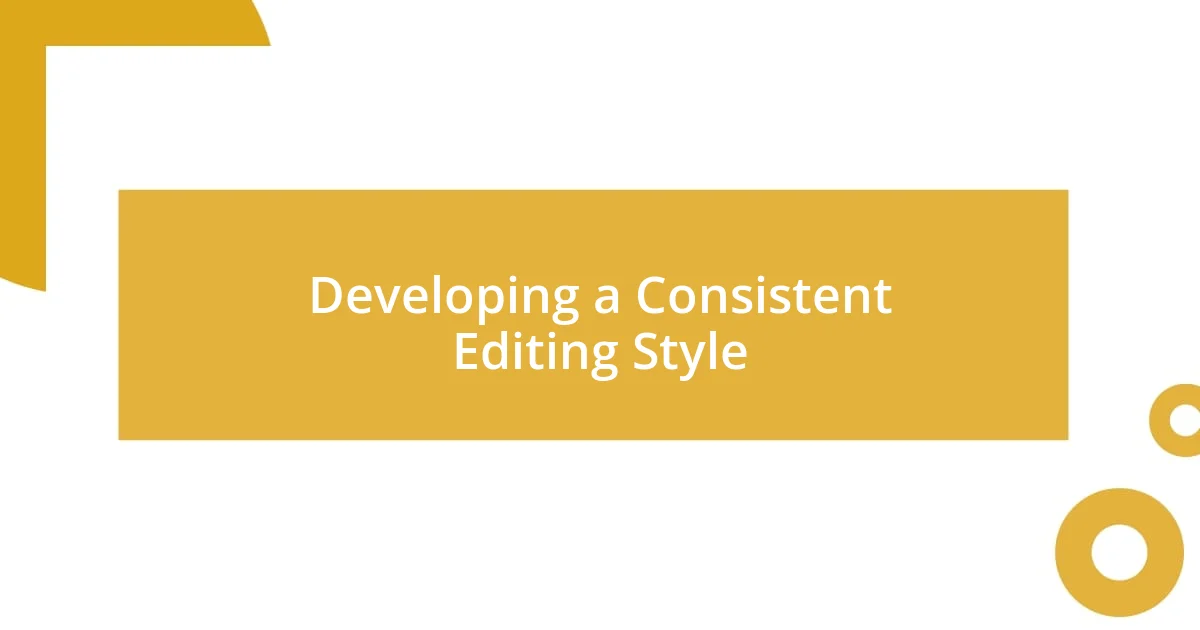
Developing a Consistent Editing Style
Developing a consistent editing style is something I’ve grown to appreciate over the years. Initially, I was like a chameleon, changing my approach based on the piece I was working on. But I realized that having a recognizable style not only enhances my writing but also creates a sense of trust with my readers. I remember getting feedback on a short story where the voice was a bit all over the place. It made me understand that consistency is key.
To establish my own editing style, I focus on a few core principles that guide my revisions. Here’s a list of what I keep in mind:
- Voice: Ensure that the unique voice of my writing shines through clearly.
- Clarity: Strive for simplicity; I always ask myself if a sentence can be made clearer.
- Pacing: Pay attention to the flow of the narrative; I search for areas that might feel sluggish or rushed.
- Point of View: Consistently maintain the chosen perspective to avoid confusing the reader.
- Tone: Keep a consistent tone that aligns with the subject matter and audience.
Having these principles helps me create a framework within which I can edit effectively. And honestly, it takes the guesswork out of the process, allowing me to make quicker, more confident editing decisions that resonate well with my readers.
On another note, I’ve learned that developing a personal touch to my editing style can really make an impact. For instance, I often like to include a favorite quote or a personal connection to the subject matter at the end of my pieces. This tiny detail wraps up my work in a way that feels cohesive and meaningful. I remember when I added a quote from my favorite author after completing a reflective piece, and I felt as if I had infused a part of my literary journey into the work. It transformed not just the piece but my entire editing approach.
As I cultivate this style, I find it helpful to look for inspiration from writers I admire. Observing their consistency in editing choices has been an eye-opener. Whether it’s the way they structure their sentences or how they weave in emotional beats, it encourages me to refine my craft continually. Adopting the aspects that resonate with me while blending them into my unique voice has made my editing style more robust and enjoyable.

Incorporating Feedback in Editing
Incorporating feedback into your editing process can be a game-changer. I remember once sharing a draft with a trusted friend who offered insights I hadn’t considered. Their perspective shifted my understanding of the piece entirely, highlighting areas where I had become too attached to my own words. How often do we overlook problems because we’ve stared at the same text for too long?
Feedback shouldn’t feel like a burden; rather, it’s a tool to enhance your writing. I often take time to sift through critiques and identify patterns. When multiple readers comment on similar aspects, it tells me there’s something significant to address. For instance, I once had a reader mention that a character’s motivation wasn’t clear, prompting me to dive deeper into their backstory. It made the final narrative stronger and more relatable.
What surprised me is how I’ve learned to approach feedback with an open mind. Initially, I used to feel defensive, but I’ve found that viewing it as an opportunity for growth transforms the editing experience. It’s about collaborating with my readers, allowing their insights to shape a richer narrative. Have you ever experienced that enlightening moment when a simple suggestion unlocked a whole new angle for your work? It’s moments like these that make incorporating feedback not just worthwhile, but essential.
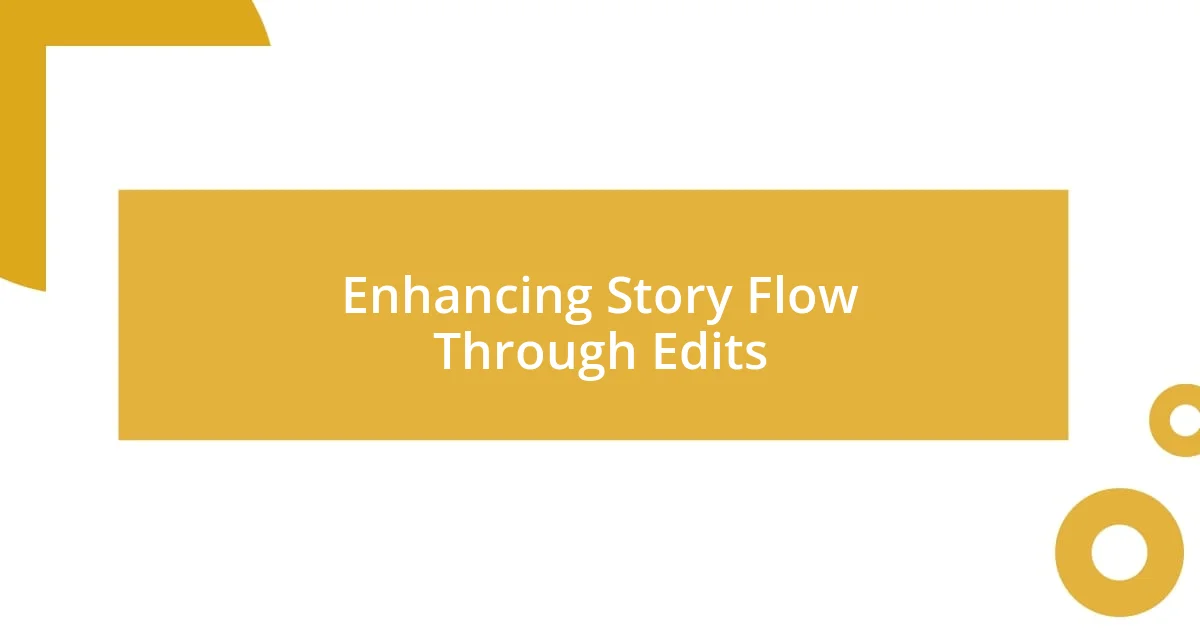
Enhancing Story Flow Through Edits
Edits can significantly enhance the story’s flow, turning what may feel like a collection of words into a seamless journey. I always keep a mental checklist, looking for areas where a sentence might disrupt the natural rhythm—like when a character pauses too long, creating a lull in action. I recall a scene I wrote where too much detail about the setting interrupted the dialogue. After trimming those extra words, the conversation flowed so much better, allowing readers to feel fully immersed in the moment.
Transitioning between paragraphs is another crucial area where I focus my editing efforts. I often ask myself, “Does this feel like a natural progression?” If it doesn’t, I revise until it does. I remember struggling with a chapter that felt disjointed; moving from one character’s perspective to another felt jarring. After reworking the transitions, not only did the flow improve, but it provided readers with a clearer emotional connection to the unfolding narrative.
When I edit, I also consider the emotional journey I want readers to experience. Each paragraph should build on the last, creating a crescendo that culminates in a satisfying climax. There was a time when I placed an emotional revelation too early in a story. Once I rearranged it, building the tension gradually, not only did I leave readers on the edge of their seats, but I also evoked a more impactful emotional response. Isn’t it fascinating how a few informed edits can shift the entire narrative landscape?
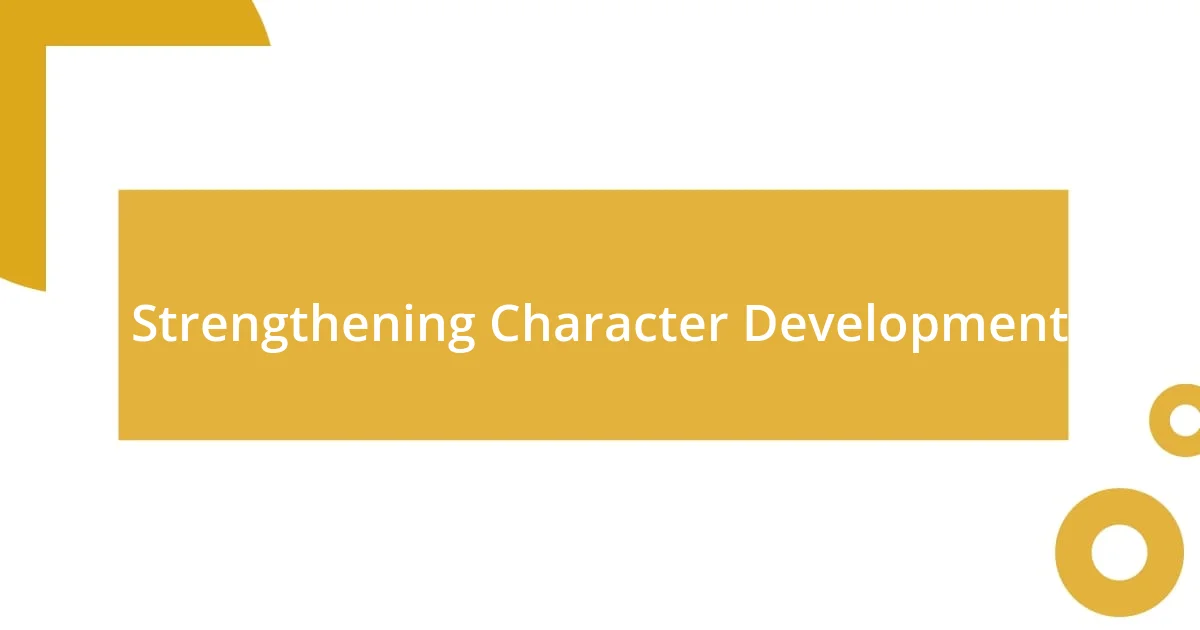
Strengthening Character Development
When it comes to character development, I find that deepening a character’s backstory can breathe life into a narrative. I once realized a protagonist I was writing acted inconsistently because their motivations weren’t fully fleshed out. Diving into their childhood memories not only made their choices more relatable but also allowed me to uncover some poignant themes driving my story. Have you ever felt that moment of clarity when a character’s past suddenly illuminated their present actions? It’s this kind of insight that can transform a flat character into a dynamic one.
Another effective technique is ensuring each character has distinct voices and personalities. I remember crafting a team of characters, each with unique quirks and dialogue styles. During revisions, I realized that some characters sounded too alike, which muddied their individuality. After a focused review, I tweaked their speech patterns and motivations, allowing their personalities to shine. It’s a rewarding process—seeing them turn into fully realized individuals that resonate with readers.
Lastly, I often emphasize the importance of character arcs. I’ve seen how an incomplete arc can leave readers unsatisfied. Reflecting on my own writing, there was a time when I neglected the transformation of a secondary character, leaving them static. Upon revisiting the manuscript, I challenged myself to craft a journey for them that felt authentic and meaningful. This not only enriched their character but also enhanced the overall narrative by weaving in an essential subplot. How do you feel about the journeys of your characters? Each arc can evoke powerful emotions, drawing readers deeper into the story.

Finalizing Edits for Impact
Finalizing your edits for impact is all about honing in on the emotional core of your story. I often find myself asking, “What do I want my readers to feel at this moment?” I once revisited a climactic scene where the emotional weight didn’t land as intended. By cutting some extraneous details and emphasizing the protagonist’s internal struggle, I transformed that moment into a heart-wrenching experience that lingered with my readers long after they turned the page.
Another vital aspect is pacing. I’ve learned that a well-timed pause can be just as impactful as a burst of action. During a recent edit, I noticed a fight scene that raced through the details, leaving little room for suspense. By strategically inserting a moment of reflection for the characters, I allowed readers to process the stakes, heightening the tension. When was the last time you felt your heart race in anticipation? That’s the kind of reaction I strive to evoke in my writing.
Lastly, I pay close attention to word choice. The right word can carry so much more weight than a string of adjectives. In one instance, I had a character describe their grief in a long, convoluted sentence. After simplifying it to a single, powerful phrase, it resonated with readers far more deeply. Isn’t it interesting how a few carefully selected words can turn a simple statement into an emotional revelation? Crafting these moments during the final editing phase is where the real magic happens.










